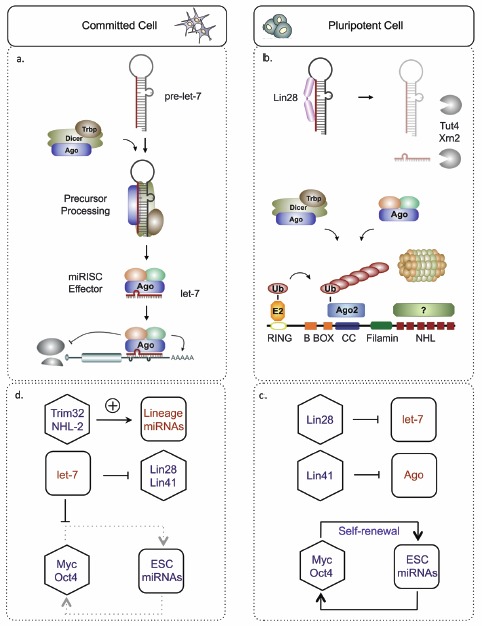From: miRNAs need a Trim Regulation of miRNA Activity by Trim-NHL Proteins

NCBI Bookshelf. A service of the National Library of Medicine, National Institutes of Health.

Summary of miRNA regulation during stem cell differentiation. a) In committed cells such as neural progenitors and their offspring, miRNA precursors such as prelet-7 are processed by a core complex of Dicer, Trbp and one of the Argonaute proteins (Ago). After cleavage, one strand is passed to an effector complex. Composition of the effector is not yet fully defined, but is centered on one Ago and associated proteins such as GW182/Tnrc6, Mov10, FMRP and Rck/p54 (in mammals). The effector mediates translational silencing and frequently enhanced mRNA decay. b) In pluripotent cells, the pre-let-7 specific RNA binding protein Lin28 blocks access to pre-let-7, which is thereby subject to uridylation and enhanced degradation. Lin41 binds Ago via the coiled-coil domain, stimulating ubiquitin-mediated proteolysis. c) In pluripotent cells let-7 maturation is inhibited by Lin28, while Ago (and perhaps additional miRISC proteins) are downregulated by Lin41. A limited class of ES-specific miRNAs participates in a positive feedback loop with pluripotency-associated transcription factors (Myc, Nanog, Oct-4, Sox2). d) Activation of let-7 results in suppression of Lin28 and Lin41. Let-7 inhibits the transcriptional program of pluripotent cells and downregulates ESC miRNAs. Trim32 (or NHL-2 in C. elegans) act to enhance miRNA activity. The signal that releases let-7 repression is not known, but presumably involves Myc and miR-125. See text and references for details.
From: miRNAs need a Trim Regulation of miRNA Activity by Trim-NHL Proteins

NCBI Bookshelf. A service of the National Library of Medicine, National Institutes of Health.